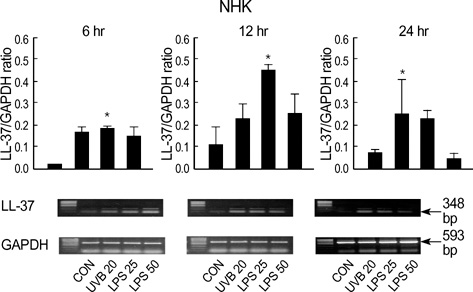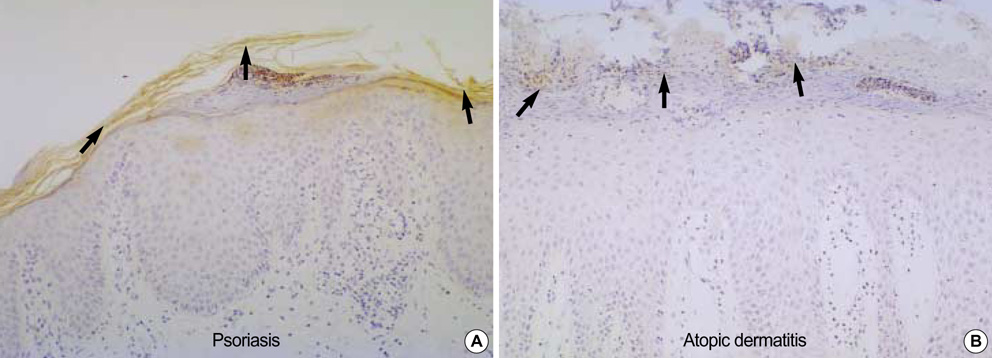J Korean Med Sci.
2005 Aug;20(4):649-654. 10.3346/jkms.2005.20.4.649.
Expression and Modulation of LL-37 in Normal Human Keratinocytes, HaCaT cells, and Inflammatory Skin Diseases
- Affiliations
-
- 1Department of Dermatology, College of Medicine, Chung Ang University, Korea. drseo@hanafos.com
- 2Chung Ang Medical Research Center, Seoul, Korea.
- KMID: 1712748
- DOI: http://doi.org/10.3346/jkms.2005.20.4.649
Abstract
- Defensins and cathelicidins (LL-37) are major antimicrobial peptides (AMPs) of the innate immune system of the human skin. In normal non-inflamed skin these peptides are negligible, but their expression can be markedly increased in inflammatory skin disease such as psoriasis. We designed this study to identify the expressions of LL-37 in normal human keratinocyte (NHK) and HaCaT cells after exposure to stimulants and to investigate difference of LL-37 expression accompanied with cell differentiation status, and come to understand difference of susceptibility to infection in atopic dermatitis and psoriasis. Expressions of LL-37 in NHKs and HaCaT cells were evaluated by using RT-PCR, Western blotting, and immunohistochemical (IHC) staining at 6, 12, and 24 hr post stimulation after exposure to Ultraviolet B irradiation and lipopolysaccharide. And expression of LL-37 in skin biopsy specimens from patients with atopic dermatitis and psoriasis was determined by immunohistochemical analysis. In time-sequential analyses of LL-37 expression revealed that LL-37 was expressed in NHKs, but not in HaCaT cells. IHC analysis confirmed the presence of abundant LL-37 in the epidermis of psoriasis. Therefore we deduced that expression of LL-37 is affected by UV irradiation, bacterial infection, and status of cell differentiation.
Keyword
MeSH Terms
-
Antimicrobial Cationic Peptides/analysis/*genetics
Blotting, Western
Cell Line
Cells, Cultured
Comparative Study
Defensins/analysis/genetics
Dose-Response Relationship, Drug
Gene Expression/drug effects/radiation effects
Humans
Immunohistochemistry
Keratinocytes/cytology/*metabolism
Lipopolysaccharides/pharmacology
Male
RNA, Messenger/genetics/metabolism
Research Support, Non-U.S. Gov't
Reverse Transcriptase Polymerase Chain Reaction
Skin/cytology/metabolism
Skin Diseases/*genetics/metabolism/pathology
Figure
Cited by 2 articles
-
Changes of Antimicrobial Peptides and Transepidermal Water Loss After Topical Application of Tacrolimus and Ceramide-dominant Emollient in Patients with Atopic Dermatitis
Kui Young Park, Dong Ha Kim, Mi Sook Jeong, Kapsok Li, Seong Jun Seo
J Korean Med Sci. 2010;25(5):766-771. doi: 10.3346/jkms.2010.25.5.766.Expression of Antimicrobial Peptides and Proteins in Epidermis Equivalents Exposed to Salt Water and Narrowband Ultraviolet B Radiation
Thilo Gambichler, Sarah Terras, Marina Skrygan
Ann Dermatol. 2014;26(5):666-668. doi: 10.5021/ad.2014.26.5.666.
Reference
-
1. Nizet V, Ohtake T, Lauth X, Trowbridge J, Rudisill J, Dorschner RA, Pestonjamasp V, Piraino V, Huttner K, Gallo RL. Innate antimicrobial peptide protects the skin from invasive bacterial infection. Nature. 2001. 414:454–457.
Article2. Fulton C, Anderson GM, Zasloff M, Bull R, Quinn AG. Expression of natural peptide antibiotics in human skin. Lancet. 1997. 350:1750–1751.
Article3. Alice LY, Delphin D, Annie VW, Christina PH, Erika VV, Lide L, Tomas G. Human β-defensin-2 production in keratinocytes is regulated by interleukin-1, bacteria, and the state of differentiation. J Invest Dermatol. 2002. 118:275–281.4. Murakami M, Ohtake T, Dorschner RA, Gallo RL. Cathelicidin antimicrobial peptides are expressed in salivary glands and saliva. J Dent Res. 2002. 81:845–850.
Article5. Woo JS, Jeong JY, Hwang YJ, Chae SW, Hwang SJ, Lee HM. Expression of cathelicidin in human salivary glands. Arch Otolaryngol Head Neck Surg. 2003. 129:211–214.
Article6. Park YM. Application of toll-like receptor in dermatological scope. Korean J Invest Dermatol. 2003. 10:1–5.7. Pivarcsi A, Koreck A, Bodai L, Szell M, Szeg C, Belso N, Kenderessy-Szabo A, Bata-Csorgo Z, Dobozy A, Kemeny L. Differentiation-regulated expression of Toll-like receptors 2 and 4 in HaCaT keratinocytes. Arch Dermatol Res. 2004. 296:120–124.
Article8. Frohm M, Agerberth B, Ahangari G, Stahle-Backdahl M, Liden S, Wigzell H, Gudmundsson GH. The expression of the gene coding for the antibacterial peptide LL-37 is induced in human keratinocytes during inflammatory disorders. J Biol Chem. 1997. 272:15258–15263.
Article9. Seo SJ, Ahn SW, Hong CK, Ro BI. Expressions of beta-defensins in human keratinocyte cell lines. J Dermatol Sci. 2001. 27:183–191.10. Gallo RL, Huttner KM. Antimicrobial peptides: an emerging concept in cutaneous biology. J Invest Dermatol. 1998. 111:739–743.
Article11. Yang D, Chertov O, Bykovskaia SN, Chen Q, Buffo MJ, Shogan J, Anderson M, Schroder JM, Wang VM, Howard OM, Oppenheim JJ. Beta-defensins: linking innate and adaptive immunity through dendritic and T cell CCR6. Science. 1999. 286:525–528.12. Grossman RM, Krueger J, Yourish D, Granelli-Piperno A, Murphy DP, May LT, Kupper TS, Sehgal PB, Gottlieb AB. Interleukin 6 is expressed in high levels in psoriatic skin and stimulates proliferation of cultured human keratinocytes. Proc Natl Acad Sci USA. 1989. 86:6367–6371.
Article13. Ong PY, Ohtake T, Brandt C, Strickland I, Boguniewicz M, Ganz T, Gallo RL, Leung DY. Endogenous antimicrobial peptides and skin infections in atopic dermatitis. N Eng J Med. 2002. 347:1151–1160.
Article14. Leung DY. Atopic dermatitis: new insights and opportunities for therapeutic intervention. J Allergy Clin Immunol. 2000. 105:860–876.
Article15. Nizet V, Gallo RL. Cathelicidins and innate defense against invasive bacterial infection. Scand J Infect Dis. 2003. 35:670–676.
Article16. Murakami M, Ohtake T, Dorschner RA, Schittek B, Garbe C, Gallo RL. Cathelicidin anti-microbial peptide expression in sweat, an innate defense system for the skin. J Invest Dermatol. 2002. 119:1090–1095.
Article17. Zaiou M, Nizet V, Gallo RL. Antimicrobial and protease inhibitory functions of the human cathelicidin (hCAP18/LL-37) prosequence. J Invest Dermatol. 2003. 120:810–816.
Article18. Dorschner RA, Pestonjamasp VK, Tamakuwala S, Ohtake T, Rudisill J, Nizet V. Cutaneous injury induces the release of cathelicidin antimicrobial peptides active against group A Streptococcus. J Invest Dermatol. 2001. 117:91–97.
Article19. Larrick JW, Hirata M, Balint RF, Lee J, Zhong K, Wright SC. Human CAP18: a novel antimicrobial lipopolysacharide-binding protein. Infect Immunol. 1995. 63:1291–1297.20. Harder J, Meyer-Hoffert U, Teran LM, Schwichtenberg L, Bartels J, Maune S, Schroder JM. Mucoid Pseudomonas aeruginosa, TNF-alpha, and IL-1beta, but not IL-6, induce human beta-defensin-2 in repiratory epithelia. Am J Respir Cell Mol Biol. 2000. 22:714–721.21. Koczulla R, Von Degenfeld G, Kupatt C, Krotz F, Zahler S, Gloe T, Issbrucker K, Unterberger P, Zaiou M, Lebherz C, Karl A, Raake P, Prosser A, Boekstegers P, Welsch U, Hiemstra PS, Vogelmeier C, Gallo RL, Clauss M, Bals R. An angiogenic role for the human peptide antibiotic LL-37/hCAP-18. J Clin Invest. 2003. 111:1643–1645.
Article22. Yang D, Chen Q, Schmidt AP, Anderson GM, Wang JM, Wooters J, Oppenheim JJ, Chertov O. LL-37, the neutrophil granule- and epithelial cell-derived cathelicidin, utilizes formyl peptide receptor-like 1(FPRL1) as a receptor to chemoattract human peripheral blood neutrophils, monocytes, and T cells. J Exp Med. 2000. 192:1069–1074.23. Dorschner RA, Lin KH, Murakami M, Gallo RL. Neonatal skin in mice and humans expresses increased levels of antimicrobial peptides: innate immunity during development of the adaptive response. Pediatr Res. 2003. 53:566–572.
Article24. Zanetti M, Gennaro R, Romeo D. Cathelicidins: a novel protein family with a common proregion and a variable antimicrobial domain. FEBS Lett. 1995. 374:1–5.25. Harder J, Bartels J, Christophers E, Schroder JM. A peptide antibiotic from human skin. Nature. 1997. 387:861.
Article26. Kim ST, Chang YS, Cha HE, Kim HB, Hwang YJ, Lee HS. Antimicrobial peptide (LL-37) expression in nasal mucosa. Korean J Otolaryngol-Head Neck Sur. Korean J Otolaryngol-Head Neck Surg. 2001. 44:1048–1052.
- Full Text Links
- Actions
-
Cited
- CITED
-
- Close
- Share
- Similar articles
-
- The Production IL-21 and VEGF in UVB-irradiated Human Keratinocyte Cell Line, HaCaT
- Hyaluronan Oligosaccharides Improve Rosacea-Like Phenotype through Anti-Inflammatory and Epidermal Barrier-Improving Effects
- Comparative Study on the Expression of ICAM-1 of Preimmune State Keratinocytes Induced by Trichophyton Antigen
- Anti-inflammatory Effect of Curcumin on UVB-induced Inflammatory Cytokines in HaCaT Cells
- Organotypic Culture of HaCaT cells: Use of Dermal Substrate that Combines de-epidermized Dermis with Fibroblast-populated Collagen Matrix





